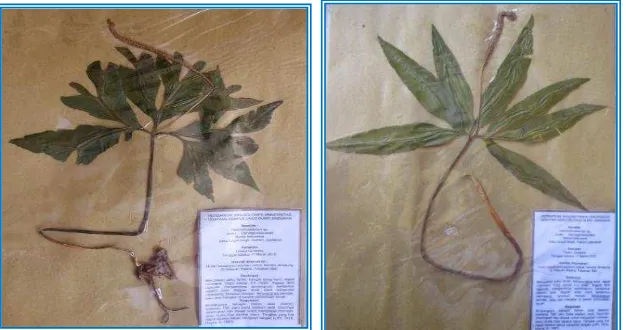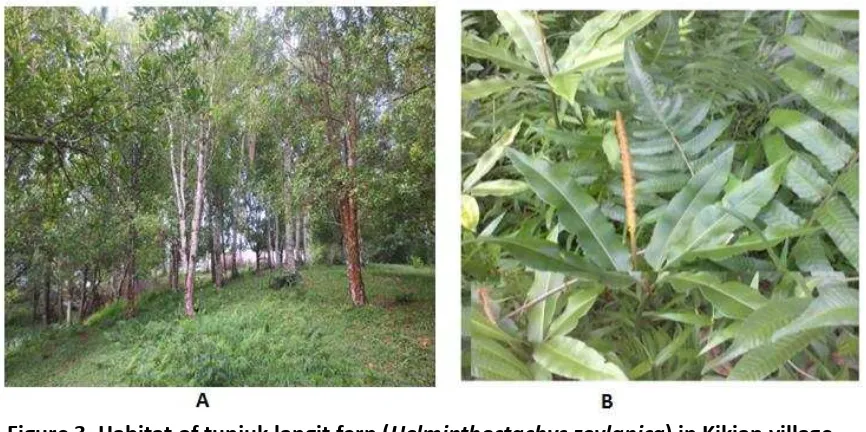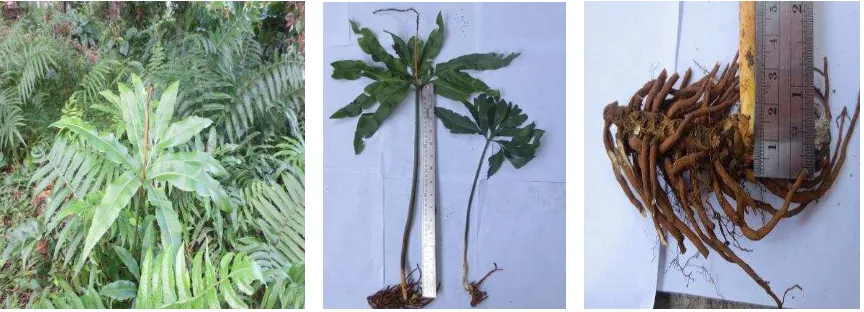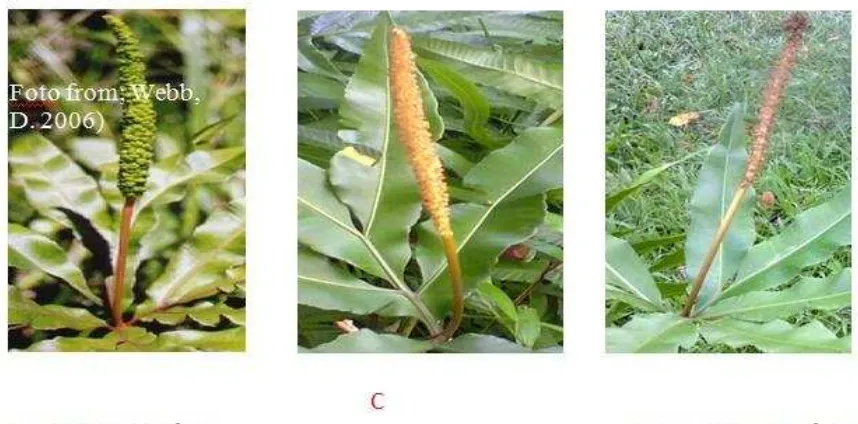Official Reprint PDF
Existence and Morphology Characteristics of
Tunjuk Langit Fern (Helminthostachys zeylanica
Hook.) in Bali
By
I.
Ketut Ginantra, Anak Agung Ketut Darmadi and Martin Joni
ISSN 2319-3077 Online/Electronic ISSN 0970-4973 Print
Global Impact factor of Journal: 0.756 Scientific Journals Impact Factor: 3.285 InfoBase Impact Factor: 2.93
Index Copernicus International Value IC Value of Journal 6.01 Poland, Europe
J. Biol. Chem. Research
Volume 32 (2) 2015 Pages No. 733-739
Journal of
Biological and
Chemical Research
An International Peer reviewed Journal of Life Sciences and Chemistry
Indexed, Abstracted and Cited: Index Copernicus International (Europe), Polish Ministry of Science and Higher Education (Poland, Europe) Research Bible (Japan), Scientific Journals Impact Factor Master List, Directory of Research Journals Indexing (DRJI), Indian Science. In, Database Electronic Journals Library (Germany), Open J-Gate, J Gate e-Journal Portal, Info Base Index, International Impact Factor Services (IIFS) (Singapore), Scientific Indexing Services (USA), International Institute of Organized Research (I2OR), Cosmos Science Foundation (South-East Asia), Eye Source, Einstein Institute for Scientific Information {EISI} and
citefactor.org
journals indexing
Directory Indexing of International Research Journals
J. Biol. Chem. Research. Vol. 32, No. 2: 733-739, 2015
(An International Peer reviewed Journal of Life Sciences and Chemistry) Ms 32/2/21/2015
I.
Ketut Ginantra, Anak Agung Ketut Darmadi and Martin Joni
Department of Biology, Faculty of Mathematic and Natural Science, Udayana University, Bali Indonesia
ABSTRACT
This study focused on the existence and morphological characteristics of the sporophyte (Sporophyll and trophophyll) tunjuk langit fern (Helminthostachys zeylanica) in Bali. The study was conducted using exploration method in some areas of rain forest, forest plantations in Bali at an altitude of 300-1,100 m above sea level (asl). The study was conducted in December 2014 to April 2015. The point coordinates of the location of the discovery of H. zeylanica specimens recorded and descriptions of habitat and morphologic character. The identification is done by comparing the specimen sample with a description H. zeylanica which refers to the LIPI, (1979), Heyne, K. (1987), Croft, J. (1999b) and Meddleton, D. (2015). Plants specimens collected for the manufacture of herbarium. The results showed that the Helminthostachys zeylanica can be found in the plantation areas of cacoa (Theobroma cacao), clove (Syzygium aromaticum) and mangosteen (Mangostana sp.) at an altitude of 352-360 m asl. in the Kikian village, Selemadeg sub-district of Tabanan- Bali. Grown in soil with high humidity and rich in organic matter. Existence of this species in the habitat is very rare. Is an annual plant, grow well in the rainy season. Habitus is a herb plants, sterile frond part (trophophyll) and fertile (Sporophyll) is different. Trophophyll composed palmatus, tripartite. Sporophyll shaped spice like with tightly attached sporangium, green color (when young) to yellow/brown (when mature). Sporophyll appears above from the base of the leaves tripartite trophophyll. Rhizome is stiff short, creeping in soil bearing the numerous fleshy roots.
INTRODUCTION
Helminthostachy szeylanica (Synonyms H.dulcis) is one of the ferns of the family Ophioglossaceae (class Polypodiopsida). Fern of these families have different morphological forms of the other fern in the same class. Frond of the fern is different between sterile leaves (trophophyll) and fertile leaves (sporophyll). Partfertile (sporophyll: contains sporangium) shaped like a spice. Part of sterile frond shaped palmatus (LIPI, 1979; Croft, J.1999a). In Indonesia H. zeylanica known as the tunjuk langit, in some areas known as varied name, including: pakupacarbumi (South Sumatra), tapakjalak/jajalakan (Sunda/West Java), Pakis Kaler, manonor pakuurang (Java) and bute-bute (Makasar/South Sulawesi). These plants widely used for traditional medicine. Rhizomeas a medicinal ingredient for dysentery, salesma, pulmonary tuberculosis at an early stage, the leaves are dried and smoked to treat nosebleeds, young leave scan be used vegetable. The old stalk can be used materials crafts (Fitrya et al., 2010; Heyne, K. 1987). Geographically spread of fern Helminthostachys sp. Is in the wet forests of Cambodia, India, the Himalayas, Japan, Laos, the Philippines, Sri Lanka, Thailand, Vietnam, Australia and the Pacific islands. In Indonesia, these plant are found in wet forest/rain forest in Java, Sumatra, Kalimantan and Sulawesi (Heyne, 1987; Kholik et al., 2011; Fitrya et al., 2010). From the research about diversity of fern in Baliby Adjie, B. & Lestari W.S. (2011), existence of the fern Helminthostachys zeylanica has not been reported. The species of fern from Ophioglossaceae groups that have been reported only Ophioglossum pendulum and Ophioglossum pendunculosum. Status of the existence of H. zeylanica in Indonesia is not yet known with certainty. Although, Joshi, B. (2011) and South China Botanical Garden, (2015) stated that the existence status of this species in China and India has been categorized as an endangered species because of exploitation and habitat destruction. Given the existence of Helminthostachys zeylanica in Bali have not been reported, although some forested areas of wet/rainforest in Bali has the potential for growth of this plant. Therefore, this study focused on the exploration of presence and morphology characteristic of the H. zeylanica in Bali.
MATERIAL AND METHODS
This research was conducted by the exploration method that is focused on rainforest land/wet forest. Which explored area is 4 forest area and plantation habitat namely in Pupuan, Selemadeg, Bedugul and Kintamani with altitude from 300 m to 1.200 m above sea level (Figure 1). The study was conducted in December 2014 and March 2015. The discovery location of tunjuk langit fern (H. zeylanica) recorded in geography coordinates, temperature, air humidity, altitude and growth habitat descriptions. The specimens of the H. zeylanica were found to be described morphological characters; habitus, leaf morphology/frond, morphology trophophyll (sterile leaves), morphology sporophyll (the part containing the sporangium). The identification was done by comparing the specimen sample with a descriptions ferns H. zeylanica which refers to LIPI (1979), Heyne K. (1987) and Jim Croft (1999b). Plants Specimen collected for the manufacture of herbarium. Making the barium refers to Frank and Perkins (2015). The selected specimens are part of the plant has grown that indicate the presence of leaves and sporangiumor complete all parts if possible. Herbarium material collected labeled (name of plants, plant origin, name of collector, collection date, short description).
Furthermore, neatly arrange din news print and oven dried ata temperature of 300Cfor 4x 24hours.Specimens that have been dry preparedon paper "mounting paper "and specimen data is placed on the right bottom of the paper (Figure 2). The herbarium is stored in the Laboratory of Plant Taxonomy Department of Biology, Udayana University.
Figure 1. Explored area and discovery location of tunjuk langit fern.
Figure 2. Herbarium specimen of tunjuk langit fern (Helminthostachys zeylanica).
RESULTS AND DISCUSSION
Discovery Location of Tunjuk Langit Fern (Helminthostachys zeylanica).
Helminthostachys sp. found only in one location, from four potential sites was explored. Location discovery this species is in crops plantation forest at Kikian village, Selemadeg district, Tabanan regency of Bali (Figure 1). The coordinates of the discovery of this plant is 80 26' 55.84" S; 1150 02' 10.22" E and 80 26' 55.09" S; 1150 02' 11.22" E, at an altitude of 352-360 m above sea level. Temperatures range from 25-30 0C and humidity between 60-90%. Population of this fern on the discovery location is extremely rare, founded only 6-10 individual at location point in the Kikian village. The existence of this fern in Bali has not been reported before (Adjie B. & Lestari, 2011). The existence of these fern in nature elusive, due to growth requires environmental factors specific (LIPI, 1979).
Manna et al. (2013) stated that Helminthostachys zeylanica very sensitive to differences in environ mental factors makes including temperature, humidity, wind velocity and water availability. In Indonesia, this fern found is generally limited to some areas in Sumatra, Java and Sulawesi (Heyne, 1987; Kholik et al., 2011; Fitrya et al., 2010). In India and China, this species have been rare category "endangered status" due to exploitation for medicinal products (Joshi, B.2011).
Habitat of Tunjuk Langit Fern (Helminthostachys zeylanica)
This plant grows in shady conditions under canopy of the tree in plantations forest. Grows as a bush associated with other species of fern among Pteris sp., Tectaria sp. and Lygodium cyrcinatum and also associated with some grass among Axonophus sp., Digitaria sp. and Oplismenus burmani (Figure 3).
This plant grows in areas with high humidity, soil rich in humus and organic matter. Able to grow in under the shade of some trees, those were cacao (Theobroma cacao), durian (Duriozibethinus), clove (Syzigium aromaticum), coconut (Cocos nucifera) and mangosteen (Mangostana sp.). Manna et al. (2013) found that this fern grows under the shade of a tree or associating with them Barringtonia acutangula, Antidesma acidum, in the Baringtonia forest Himalayas. Joshi B. (2011) also found that H. zeylanica is grown in association with trees including Tectona grandis, Eucalyptus hybrid, Acacia catechu, Dalbergiasisso and Albizzia procera in the wet forests of the Himalayas. H. zeylanica an annual plant grows well in the wet season from December to reach maturity sporangium on March /April. When the dry season, the rhizome and spore dormancy in the soil. Kholiket al. (2011) suggest that H. zeylanica fern grows in moist secondary forest and also in industrial forest plantations (HTI) at a altitude of 60-250 m above sea level in East Kalimantan. Joshi B. (2011) also stated that this species of fern grows well in moist forest areas, organic rich soil at an altitude of 235-275 m above sea level places in the Himalayas.
Figure 3. Habitat of tunjuk langit fern (Helminthostachys zeylanica) in Kikian village, Selemadeg district, Tabanan Regency, Bali)
(A: plantations forest; B: associated tunjut langit fern with some other underground plants).
Morphological characteristics
This fern is a terrestrial plant, habitus is small herb (herbaceous), plant height of about 30-68 cm from the base of frond ground until the end of the sporangium. The frond of this plant differentiated between the sterile and fertile part. Part of sterile frond (trophophyll) composed palmatus, divided into 3 parts leaf (tripartite), each with a terminal lobe and one or two pairs of lateral lobes are sessile. Lobes shape oblong to oblong-lanceulatus, the edges acutus at the tip (apex), cuneatus and somewhat decurent in the basal, pinnate leaf veins. Rhizomes form (part of the stem) short stiff, creeping, brown colour and propagates below ground level, with fleshy roots coming out of the rhizome. Rhizome diameter size between 8-11 mm (Figure 4).
Figure 4. Frond morphology of tunjuk langit (Helminthostachys zeylanica).
(A: habitus of tunjuk langitin the habitat; B: part of rhizome, trophopylldan sporangium; C: park of rhizome
Figure 5. Sporophyll morphology that spike like shape
(A: Sporophyll part (a) and tripartite trophophyll (b), B : Stalk part and spike of sporophyll, C: Sporangium development from young with green color until mature with
yellow/brown color).
Fertile part called sporophyll shaped a spike like, where sporangia attached. Sporophyll length of about 12-26 cm from the bottom leaves trophophyll (or from base of tripartite trophophyll). Sporophyll consists of the stalks with a length of about 5-11 cm and parts spike (containing sporangium) of about 7-15 cm. Young sporangium is green color, compact in spike, when the mature sporangium is yellow to brown, mature spores will be separated from the stalk spike (Figure 5).
CONCLUSIONS
Helminthostachys zeylanica found in plantations / plantation cacao /clove near the rain forest at an altitude of 352-360 m above sea level in the Kikian village, Selemadeg district, Tabanan, Bali. Grown on soils with high humidity and rich in organic matter. Is an annual plant, grows well in the wet season. Existence of this species in the habitat is very rare. Plant habitus is herb, part of sterile frond (trophophyll) and fertile (sporophyll) is different. Frond part trophophyll composed palmatus, divided into 3 parts leaf (tripartite). Sporophyll part shaped spke like with tightly attached sporangium, green (when young) to yellow/brown (when mature). Sporophyll appears above the base of the leaves trophophyll (tripartite). Rhizomes are stiff, short, creeping in soil that contains a number of fleshy roots.
ACKNOWLEDGEMENTS
We would like to thank Mr. Nengah Sukadana (traditional leaders), which has allowed us to do some research (and samples collecting) on the site of crops plantation belonging to residents of rural communities Kikian, Selemadeg district Tabanan-Bali.
REFERENCES
Adjie B. and Lestari, W. S. 2011. Flora Indonesiana: Ferns of Bali. Bali Botanic Garden, Indonesian Institute of Sciences, Baturiti, Tabanan, Bali, Indonesia – 82191.
Available at http://www.krbali.lipi.go.id
Croft, J. 1999a. A Classification of the Ferns and Their Allies. Australian National Herbarium Centre for Plant Biodiversity Research. Dikutipdari.
http://.anbg.gov.au/fern/taxa/classification.html. Opened: 5 December 2006. Croft, J. 1999b. Pteridophytes: The Ferns and Their Allies.
Available at: http://www.cpbr.gov.au/fern/taxa/pteridophyte.html
Heyne, K. 1987.Indonesia Useful Plant. Part I. Forestry Ministry. Jakarta. 80 -81.
Joshi, B. 2011. Ecology and Medicinal Uses of Helminthostachys zeylanica (L.) Hook. A e da gered flora of I dia reported at Foothills of Ku au Hi alaya Kashipur , Uttarakhand. Researcher, 2011; 3 (4) http://www.sciencepub.net/researcher.
Kholik A., Suprianto, A.dan T. Rostiwati. 2011. Cultivation of Manon (Helminthostachys zeylanica Hook) to support Raw Material Supply Continuity for Woven Craft at East Borneo. Tekno Hutan Tanaman. Vol.4 No.1, April 2011, 19 – 25.
LIPI. 1979. Fern Species in Indonesia. National Biology Affiliation-LIPI, Bogor
Manna, S., P.Kamilya, T. K. Ghara & A. Roy. 2013. Helminthostachys zeylanica in Barringtonia Swamp Forest: A Phyto association Analysis. Global Journals Inc. (USA). Volume 13 Issue 5 Version 1.0 Year 2013.
Middleton, D. 2015. Helminthostachys zeylanica (L.) Hook. Royal Botanic Garden Edinburgh. Stuart Lindsay, the Singapore Botanic Gardens. Available at: http://rbgweb2.rbge.org.uk/thaiferns/factsheets/index.php?q=Helminthostachys_ zeylanica.xml
South China Botanical Garden 2015. Helminthostachys zeylanica in a Check list For the South China Botanical Garden, Guanghzou, Guangdong Province, P.R. China @ efloras.org. Available at: http: //www.efloras.org.
Corresponding author: I. Ketut Ginantra, Department of Biology, Faculty of Mathematic and Natural Science, Udayana University, Bali Indonesia
Email: [email protected]



